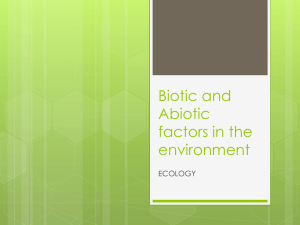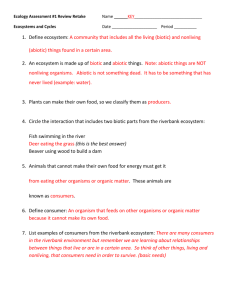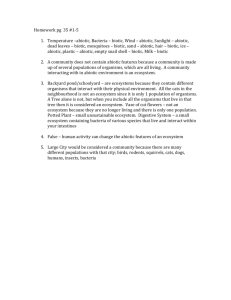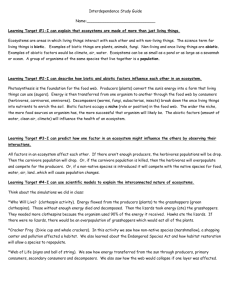"What is an Ecosystem?" Reading
advertisement
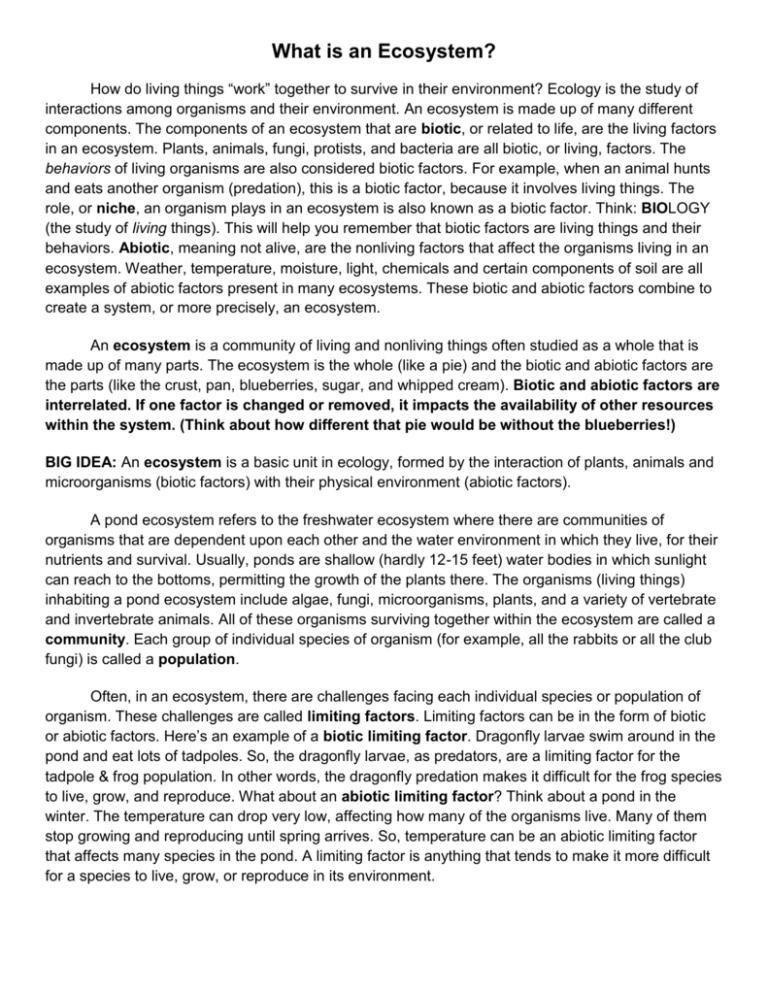
What is an Ecosystem? How do living things “work” together to survive in their environment? Ecology is the study of interactions among organisms and their environment. An ecosystem is made up of many different components. The components of an ecosystem that are biotic, or related to life, are the living factors in an ecosystem. Plants, animals, fungi, protists, and bacteria are all biotic, or living, factors. The behaviors of living organisms are also considered biotic factors. For example, when an animal hunts and eats another organism (predation), this is a biotic factor, because it involves living things. The role, or niche, an organism plays in an ecosystem is also known as a biotic factor. Think: BIOLOGY (the study of living things). This will help you remember that biotic factors are living things and their behaviors. Abiotic, meaning not alive, are the nonliving factors that affect the organisms living in an ecosystem. Weather, temperature, moisture, light, chemicals and certain components of soil are all examples of abiotic factors present in many ecosystems. These biotic and abiotic factors combine to create a system, or more precisely, an ecosystem. An ecosystem is a community of living and nonliving things often studied as a whole that is made up of many parts. The ecosystem is the whole (like a pie) and the biotic and abiotic factors are the parts (like the crust, pan, blueberries, sugar, and whipped cream). Biotic and abiotic factors are interrelated. If one factor is changed or removed, it impacts the availability of other resources within the system. (Think about how different that pie would be without the blueberries!) BIG IDEA: An ecosystem is a basic unit in ecology, formed by the interaction of plants, animals and microorganisms (biotic factors) with their physical environment (abiotic factors). A pond ecosystem refers to the freshwater ecosystem where there are communities of organisms that are dependent upon each other and the water environment in which they live, for their nutrients and survival. Usually, ponds are shallow (hardly 12-15 feet) water bodies in which sunlight can reach to the bottoms, permitting the growth of the plants there. The organisms (living things) inhabiting a pond ecosystem include algae, fungi, microorganisms, plants, and a variety of vertebrate and invertebrate animals. All of these organisms surviving together within the ecosystem are called a community. Each group of individual species of organism (for example, all the rabbits or all the club fungi) is called a population. Often, in an ecosystem, there are challenges facing each individual species or population of organism. These challenges are called limiting factors. Limiting factors can be in the form of biotic or abiotic factors. Here’s an example of a biotic limiting factor. Dragonfly larvae swim around in the pond and eat lots of tadpoles. So, the dragonfly larvae, as predators, are a limiting factor for the tadpole & frog population. In other words, the dragonfly predation makes it difficult for the frog species to live, grow, and reproduce. What about an abiotic limiting factor? Think about a pond in the winter. The temperature can drop very low, affecting how many of the organisms live. Many of them stop growing and reproducing until spring arrives. So, temperature can be an abiotic limiting factor that affects many species in the pond. A limiting factor is anything that tends to make it more difficult for a species to live, grow, or reproduce in its environment. Name __________________________________________ Bell: ______ Date: ________________ What is an Ecosystem? Worksheet Vocabulary: 1. ________________________: The study of interactions among organisms and their environment. 2. ________________________: A community of living and nonliving things often studied as a whole that is made up of many parts. 3. ________________________: Living or related to life 4. ________________________: Not alive 5. ________________________: Role an organism plans in its ecosystem 6. _______________________________: Challenges facing each individual species or population of organism that limit the size of the organism’s population. 7. ___________________________: Each group of individual species of organism. 8. ___________________________: All organisms surviving together within an ecosystem. Comprehension: 1. Based on the definitions of Ecology and Biology, what do you think the following word parts mean? EcoBioOlogy2. Provide three examples of each from the text. a. Abiotic Factors: b. Biotic Factors: 3. How is an ecosystem similar to a pie? 4. What is the difference between a population and a community? 5. Classify the factors in the following picture as either biotic or abiotic. Biotic Abiotic 6. How do humans affect the ecosystems they live in? ________________________________________________________________________________ ________________________________________________________________________________ ________________________________________________________________________________ 7. Write a story of about how abiotic and biotic factors play a role in your life. You need to include at least 3 abiotic factors and 3 biotic factors and list them or draw them at the end. ________________________________________________________________________________ ________________________________________________________________________________ ________________________________________________________________________________ ________________________________________________________________________________ ________________________________________________________________________________ ________________________________________________________________________________ Biotic: ___________________________________________________________________________ Abiotic: __________________________________________________________________________





